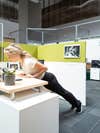This quick workout will help your sore hips and back
Pilates-inspired moves to fit in fitness in your office or kitchen.
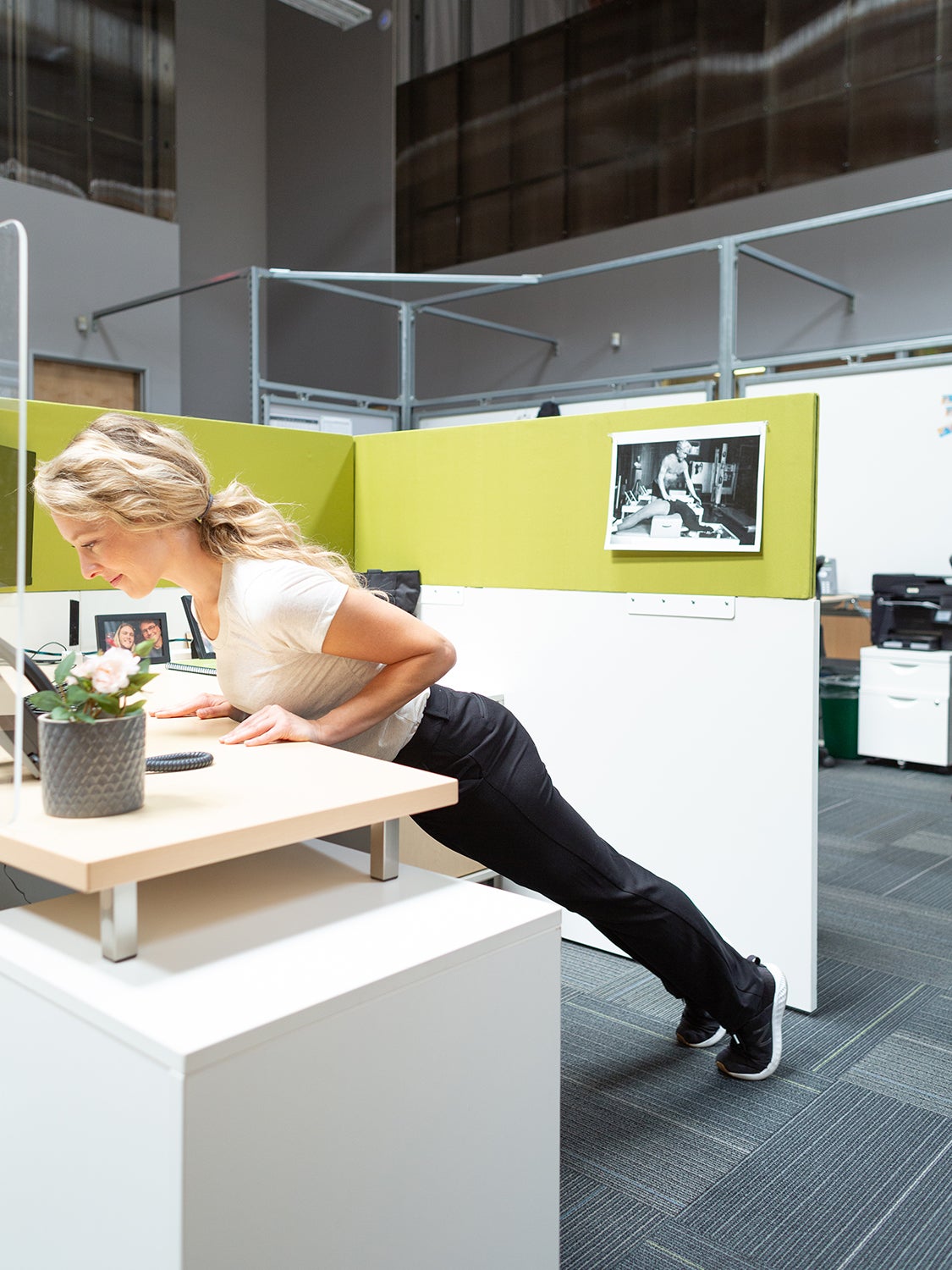
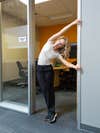
Joy Puleo, mother of two, has been in the fitness industry for more than 24 years and is currently the Education Program Manager at Balanced Body, the leading Pilates education and equipment manufacturing company. She is also the founder of Body Wise Connection, an organization which brings fitness and Pilates-inspired movement to women newly diagnosed with breast cancer.
This story originally featured on Working Mother.
For working moms, time is precious. With so much on our plates, it’s not surprising that when we’re working, we’re staying focused and sitting for long periods of time. Recent studies show an alarming number of Americans sitting for eight hours a day. Often referred to as the “new smoking,” the deconditioning effects, including decreased cardiovascular health and increased susceptibility to diseases such as diabetes and some cancers, are similar to the ill effects of smoking.
In addition, sitting too long leads to muscle weakness and imbalances, leaving us vulnerable to chronic discomfort and pain. Energy levels and mental states are impacted, as are vulnerabilities to obesity, energy loss and feelings of discontent and depression. What stands, literally, between the deconditioning cycle and health, is movement.
This simple, 20-minute Pilates-inspired workout is designed to fight the negative effects of sitting, increase flexibility and circulation, and enhance overall health and vitality. They can be done standing at your desk.
Heel raises
From tall standing posture, rise up onto the balls of your feet. As you lower heels back to the ground, keep lengthening and reaching the crown of your head to the ceiling. In other words, as you lower heels to the ground, imagine you are actually getting taller. This will not only work ankles and feet but also postural muscles along your spine. Five to eight of these will leave you feeling grounded in your legs, taller and more upright.
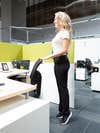
Standing roll down
Take a moment to take stock in your standing posture. Nod your head, then imagine rolling through your spine, one vertebra at a time. Roll down as far as comfortable and stop if you experience any back pain. As you roll down imagine drawing your abdominals in and up to support the front of your spine.
Note: If the floor seems too far away, stand close to a desk and roll down until your hands find support of the desk. Once the desk is achievable, then try for something lower, such as a chair seat and finally, the floor. To reverse, plant feet firmly into the ground and start to roll up your spine. As you return to standing, imagine stacking one vertebra on top of the one below it. Three to five of these are plenty.
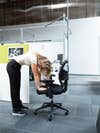
Leg stretches
Keep these stretches dynamic by keeping movement continuous. Repeat as desired.
Hamstrings (back of the thigh): From the roll down position, bend your knees and bring your thighs toward your chest, as close to your thighs as possible. From this position, straighten your legs while trying to keep your chest as close to your thighs as possible.
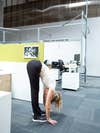
Adductors (inner thigh): Open your legs wider than hip width and place your hands on a counter, table or desk. Shift weight to one leg by bending your knee. Keep your other leg straight; this leg should feel the stretch. Repeat on the other side.
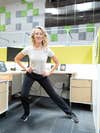
Abductor (outside of the thigh): Stand beside a desk. For a deeper stretch, stand under a doorway. Cross your right leg in front of your left at the ankles. Place your left hand on a table or hold onto the door jam. Side bend to the left. As you do so, you can reach your right arm up and overhead. If you’re inside of the door jam, hold the jam as you focus on stretching into your right hip.
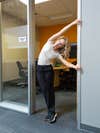
Standing reach and extension
Standing upright, open your arms out to the side, raise your arms overhead, and reach for the ceiling while extending the spine. Release by lowering arms, bending knees and flexing spine. Repeat.
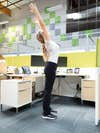
Squats and lunges
As fitness staples, these are excellent for building leg strength and strengthening pelvic floor.
Squats
Narrow: Stand with your legs hip width or slightly wider, feet parallel. Lower into a squat by bending at the hips, knees and ankles. Keep your spine straight as your torso tilts over your thighs. At the bottom of the squat you should feel work in your quadriceps and hamstrings, and your weight should be balanced over your legs.
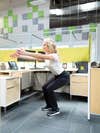
Wide: Open legs wider than your hips and slightly turn out your legs. With a wider stance you can lower farther down.
Try 10 repetitions, then on the final repetition, hold your position and count to 10 slowly. You can also pulse in squat position. Try lifting heels as you pulse and wow, quads on fire!
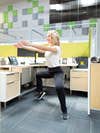
Lunges: Ten repetitions of each lunge in succession will create strength and muscular balance quickly.
Back leg focus: Stagger your legs in a split stance, one forward and one behind. Keep your torso upright and spine straight. Bend both knees and lower into a lunge. Your back knee should be directly under your pelvis, creating a straight line from head to torso to knee. Note: for support, place one hand on a desk as you lower into the lunge. Just that small amount of contact will allow you to lower deeper, while providing control and balance.
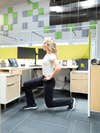
Front leg focus: Stand tall with weight even on both legs. Step forward with one leg and bend your knee to lower into a lunge. Keep your back leg straight and tilt your body forward over the lunging leg.
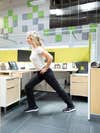
Sidestepping: From standing, step out to the side with your right leg while stepping behind with the left. Bend both knees and lower into a side-stepping lunge. Stand up to return to starting position and reverse sides.
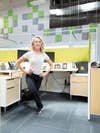
Countertop push-ups
Place your hands on top of a desk, and step back until your body is in one long diagonal line. Bend and straighten your arms. As your arms bend, your body lowers toward desk; as your arms straighten, your body returns to starting position. Although your arms are working hard, your spinal muscles and core are working to support the spine, and legs should be active to support lower body. Ten repetitions is all you need.
